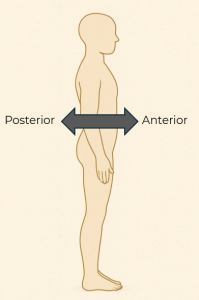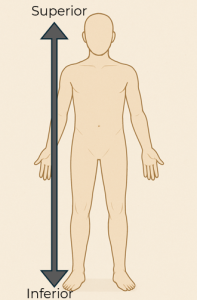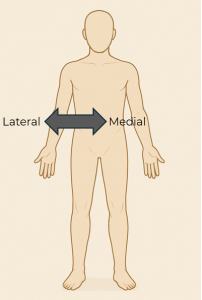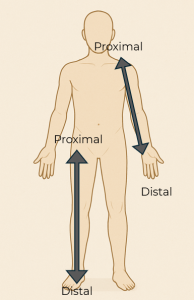3.4 Directional Terms
Directional terms help us describe where body parts are in relation to each other. Think of it like giving directions on a map, but instead of streets, we’re talking about parts of the body. These terms always use anatomical position as the starting point.
Anterior/Posterior

Anterior: Towards the front of the body
Posterior: Towards the back of the body
Examples:
- Your chest is anterior to your spine (your chest is in front of your spine)
- Your shoulder blades are posterior to your ribs (your shoulder blades are behind your ribs)
Think of it like this: If you’re standing straight, your belly button is on the anterior side, and your back is on the posterior side.
Superior/Inferior

Superior: Above
Inferior: Below
Examples:
- Your head is superior to your shoulders (your head is above your shoulders)
- Your knees are inferior to your hips (your knees are below your hips)
Think of it like this: In a building, the second floor is superior to the first floor. The basement is inferior to the main floor.
Medial/Lateral

Medial: Toward the middle of the body
Lateral: Toward the sides of the body
Examples:
- Your nose is medial to your ears (your nose is closer to the middle of your face)
- Your shoulders are lateral to your chest (your shoulders are toward the sides of your body)
Think of it like this: Draw an imaginary line down the middle of your body — things closer to that line are medial, things farther from it are lateral.
Note: These terms are typically used to describe body parts located at the head, torso, and abdomen.
Proximal/Distal

Proximal: Closer to where the arm or leg attaches to the body
Distal: Farther away from where the arm or leg attaches to the body
Examples:
- Your shoulder is proximal to your hand (your shoulder is closer to your body)
- Your fingers are distal to your elbow (your fingers are farther from your body)
Think of it like this: If your arm is like a tree branch, the part of the branch near the trunk is proximal, and the leaves at the end are distal.
Note: These terms are exclusively used to describe body parts located between the shoulder joint and the hand, as well as the hip joint and the foot.
Summary of Terms
| Term | Meaning |
|---|---|
| Anterior | Front of the body |
| Posterior | Back of the body |
| Superior | Above |
| Inferior | Below |
| Medial | Toward the middle of the body |
| Lateral | Toward the sides of the body |
| Proximal | Closer to where the limb attaches |
| Distal | Farther from where the limb attaches |
Try This!
Let’s test your knowledge of directional terms. Drag each term to its matching sentence.
Text Description
- 1. The chest is _____ to the spine.
- 2. The nose is _____ to the ears.
- 3. The arms are _____ to the torso.
- 4. Shoulder blades are _____ to the ribs.
- 5. The head is _____ to the shoulders
- 6. The knees are _____ to the hips.
- 7. Fingers are _____ to the elbow.
- 8. The elbow is _____ to the wrist.
- medial
- posterior
- proximal
- lateral
- superior
- anterior
- inferior
- distal
Correct Answers:
- The chest is anterior to the spine.
- The nose is medial to the ears.
- The arms are lateral to the torso.
- Shoulder blades are posterior to the ribs.
- The head is superior to the shoulders
- The knees are inferior to the hips.
- Fingers are distal to the elbow.
- The elbow is proximal to the wrist.
All images: OpenAI. (2025). ChatGPT. [Large language model]. https://chat.openai.com/chat. Prompt: Create a generic, simplified image of the human body that is a faceless mannequin and represents a neutral anatomical model in both front and side profile. Modifications: Added text and arrows.

